Need A Tourism Break? Five Ways to Escape the Summer Crowds in Split
August 6, 2022 - If you're looking for a break from the summer crowds in Split, we don't blame you. But that doesn't mean there aren't ways to escape.
Split tourism has been a bit... different this summer. With crowds larger than ever (it seems) and very little control over them in the UNESCO-protected center (you can read more about that here), the Split tourism bomb has well and truly gone off this season, and we still have a ways to go.
With travel returning after the pandemic and a season that started earlier than ever, it's felt like summer in Split since Easter - with sunny and warm days to boot. But Split's historic core isn't necessarily adapted for hordes of tourists (we don't think Diocletian had this in mind), making the center almost unbearable at times as swarms of sweat-drenched travelers make their way through narrow cobblestone streets.
Fortunately, Split is much larger than its Old Town, and if you want a break from the buzz, we have you covered.
So, how to beat the crowds in Split?
Marjan
Okay, we know this is a foolproof answer, but that green hilltop known as the city's lungs actually serves a great purpose for those looking to stretch their legs in nature. Best in the early morning for a hike up the hill, followed by coffee with Split's best view from Vidilica, or at sunset for a swim at many of its beaches, Marjan has always been a go-to for locals looking for a slice of peace during summer tourism chaos. Rent a bike to ride around, strap on your walking shoes for a sunset stroll, or post up at Bene beach for the day surrounded by pines and the buzzing of cicadas.
Shopping malls
Did you know that Split has 3 (air-conditioned) shopping malls, all a short drive outside of the city center? We know that shopping malls might not necessarily be high on your list when you're here to visit a 1700-year-old Roman masterpiece, but if you're looking for a break from sightseeing and need a minute to cool off, Split's shopping malls are not a bad place to be. Joker is the closest to the city center, about a 15-minute walk (which we don't suggest in this heat) or a 5-minute taxi ride. Mall of Split and City Center One are a bit further outside the center but still less than a 15-minute drive. Not only does each shopping mall offer an array of brands, but you'll find extra-air-conned cinemas, content for kids, and fun food courts. Again, we know it isn't the best option, but desperate times call for desperate measures when it's 35+ degrees Celsius. Treat yourself.
Bura Line - Slatine
My favorite getaway this summer is hopping on the 9:30 am Bura Line and heading to Trogir for the day. But only because my parents live nearby. Trogir is no better with crowds this summer, but one stop on the Bura Line is still a safe haven this summer - Slatine on Čiovo Island. A 30-minute boat ride from Split to Slatine has you on the beach in no time - and for only 30 kuna! This small fishermen's village and low-key tourist resort located on the northeastern side of the island doesn't have too much to offer. However, it boasts several stunning beaches, the most beautiful of which is Kava, just 1 kilometer from Slatine town. The Bura Line offers four connections daily in the high season, allowing travelers to comfortably spend the day away from Split.
Museums
Tourists may not take enough advantage of Split's museums, and there are many to explore. Split's most prized museum is undoubtedly the Meštrović Gallery, located around the bend from Sustipan park and conveniently behind Ježinac, allowing visitors to mix the work of 20th-century sculptor Ivan Meštrović with a swim. And if you are looking for something more central? Don't miss the interactive and immersive Museum of Illusions, or stop by Split's oddest institution - Froggyland. Who knows, you may discover a new love for taxidermy frogs? Pro tip: If you're looking for a quick but unmatched Virtual Reality experience of Split and its fascinating Roman history - you'll need to set aside 15 minutes for Diocletians' Dream!
Day trips
We know you're here to visit Split, but its surroundings are spectacular and shouldn't be missed. If you want to keep it local, head to the ancient ruins of Salona in the town of Solin, easily reachable by Promet bus from HNK (to Širina) or taxi (both around 15-20 minute ride depending on traffic). Klis Fortress is also just 12 kilometers outside Split and reachable by local bus or taxi. Open every day from 8:30 pm to 10 pm, don't forget that your ticket price also includes a visit to the Interpretation Center at Mejdan Square and the Stella Croatica ethno-agro park, where you can taste homemade olive oil and local traditional products for a 'multi-sensory experience of Dalmatia’s heritage.' And should you get really hungry? The Stella Croatica tavern offers local Dalmatian dishes served in the courtyard of the estate’s central square!
For more, make sure to check out our dedicated travel section.
Eight Must-Visit Croatian Castles, Fortress, and Citadels
June 23, 2022 - In this small guide to Croatian castles, fortresses, and citadels you will find some of the many walled wonders that you can explore in the country, to add a bit of history to your vacation.
It is well known why Croatia is one of the countries where HBO producers set their sights on adapting the acclaimed and popular Game of Thrones novel. Although Croatia is widely known for its Illyrian and Roman heritage thanks to its palaces and amphitheater, many of its castles and fortresses help to display a more medieval side of the country.
For those who have a particular interest in the feudal and medieval history of Croatia, here we review some of the main Croatian castles, fortresses, and citadels that are worth visiting.
Pula Castle
The Pula Castle is a star-shaped castle with four bastions that was built in 1630 to protect the city and its harbor because of its great significance in maritime trade in the North Adriatic. The Venetians commissioned the building of the Castle to the French military architect Antoine de Ville. This was most probably the site of an earlier fortress dating from the pre-Roman and Roman periods. Today the Castle houses the Historical Museum of Istria.
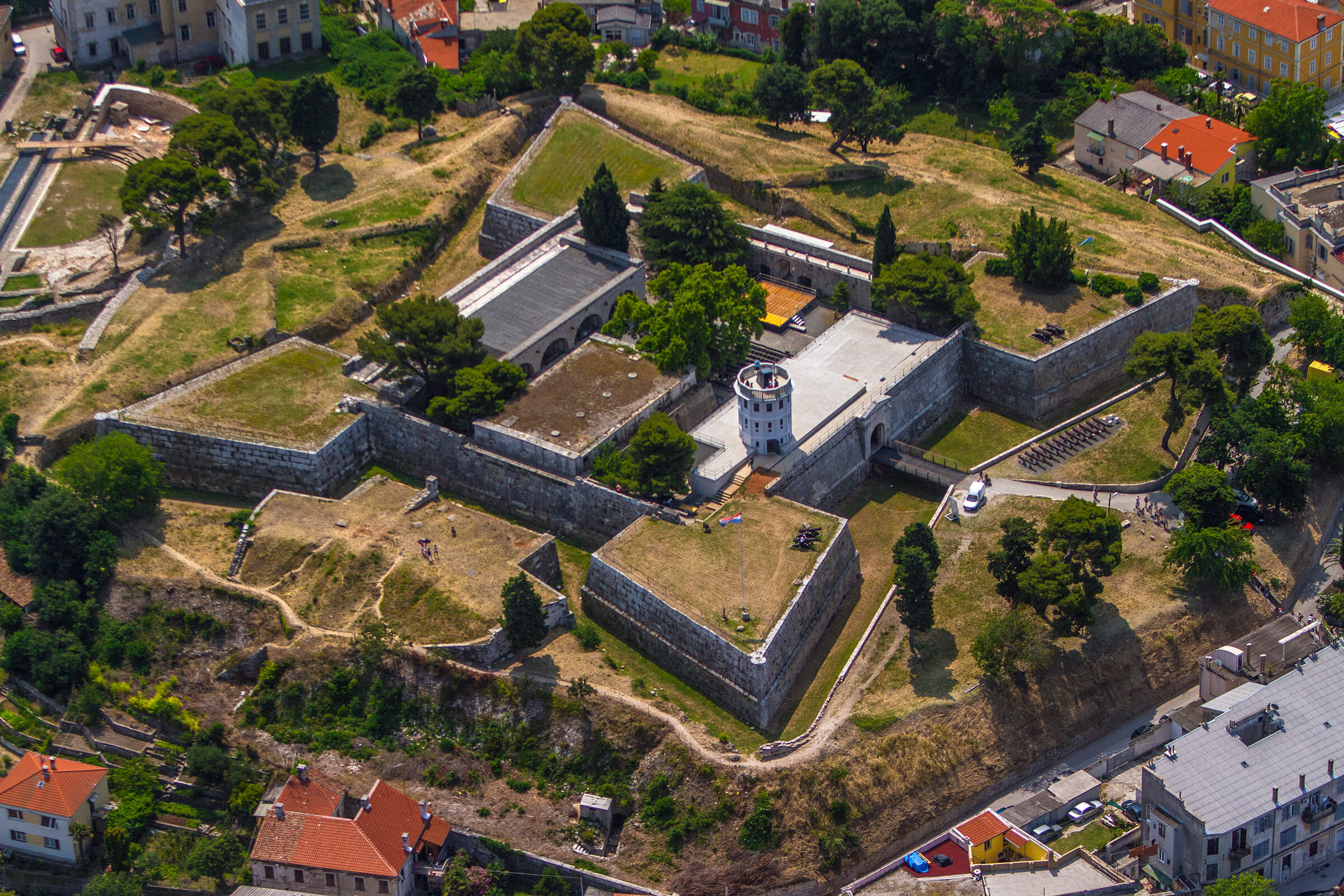
Image: Pula Tourist Board
Trsat Castle
The Trsat Castle served as a lookout on a hill 138 meters above sea level, now overlooking the city of Rijeka. It was mentioned as a parochial center for the first time in 1288. At this same site, there was a Liburnian observation post from prehistoric times, used for monitoring the roads leading from the hinterland to the coast. This location served well for the Romans to establish their defense system, the so-called Liburnian limes, whose starting point was the Tarsatica fortress town, located now in Rijeka's Old Town.
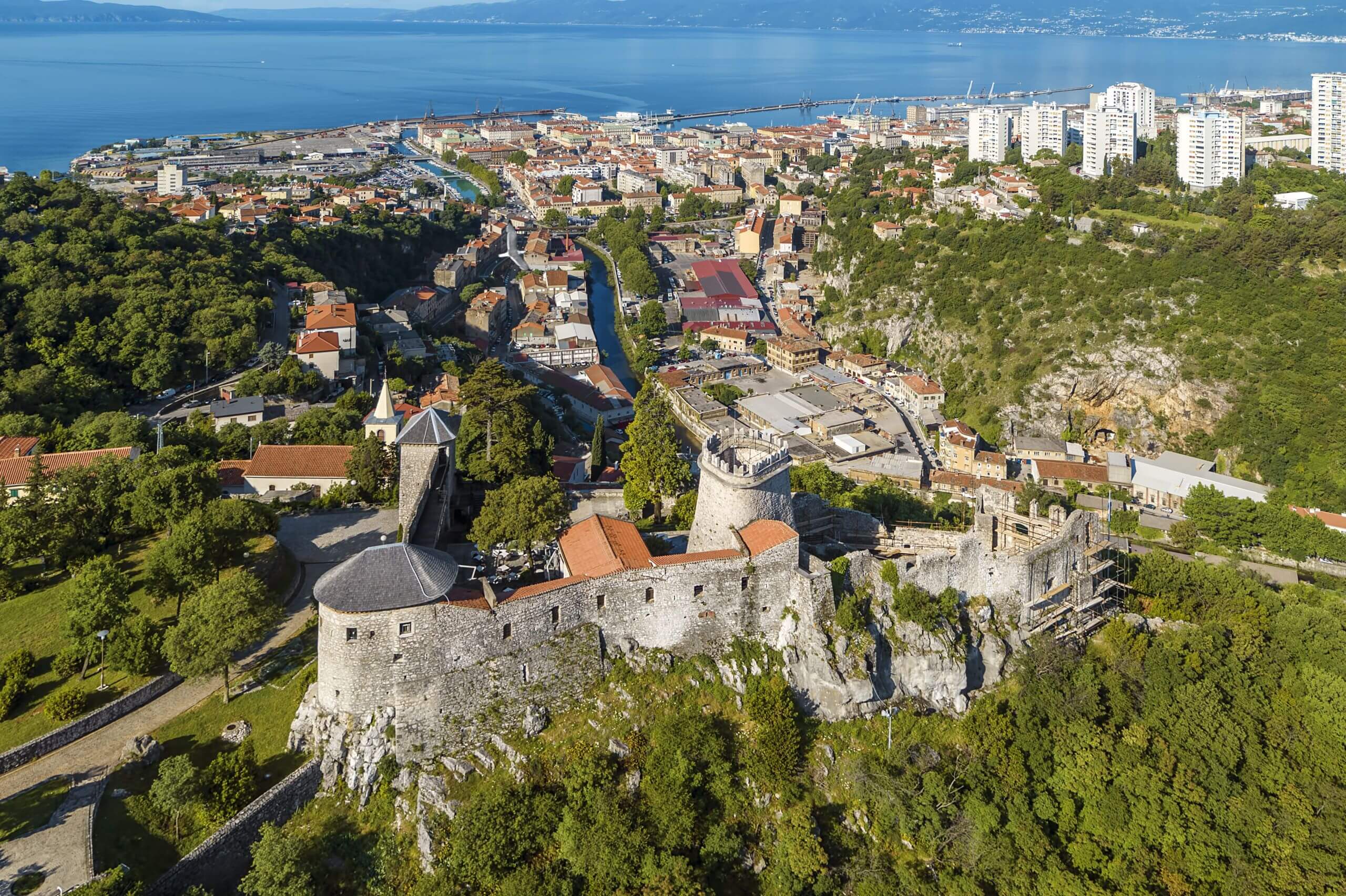
Image: Rijeka Tourist Board
Dubovac Castle in Karlovac
The Dubovac castle is one of the best-preserved and most beautiful monuments of feudal architecture in Croatia. It was built on a hill above the Kupa river and was named after an oak that grows on the surrounding slopes. It changed owners throughout history, changing its appearance depending on current needs and fashion, and got its present appearance after a complete reconstruction in the mid-20th century. It is not known exactly when did construction begin, but books say that it was finished during the 13th century.

Image: Karlovac Tourist Board
Trakošćan Castle
The Trakošćan castle was built at the end of the 13th century in the defense system of northwestern Croatia as a small observation post to monitor the road from Ptuj to the Bednjan valley. According to the legends, the Trakošćan castle got its name from the Thracian fortress, which allegedly existed in ancient times. Another surviving tradition says that it was named after the Drachenstein knights who ruled the area in the early Middle Ages. A museum with a permanent exhibition was founded in 1954.
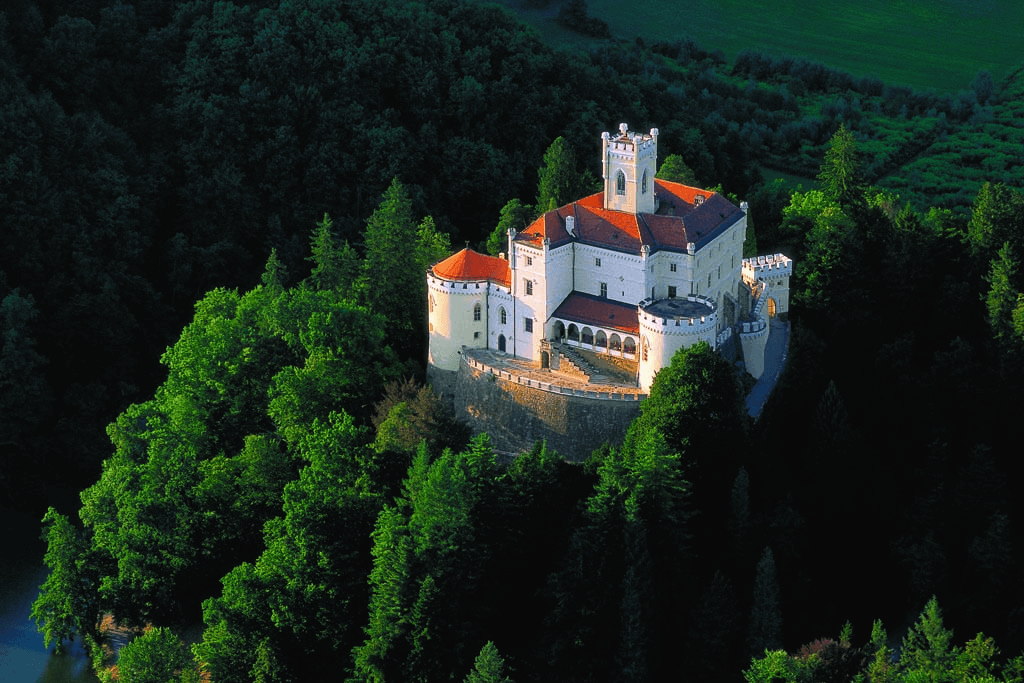
Image: Trakošćan
Varaždin's Old Town
Varaždin’s feudal fortress, known from ancient times as the Old Town, is undoubtedly the most significant historical building in the city. Unlike the royal free city that grew next to and around it, the fort was the heart of the noble estate, which was separate in terms of ownership and law. Disputes between its inhabitants with the citizens of Varaždin were frequent. The fort was built intermittently from the 14th to the 19th century, and its oldest part is the central tower adorned with Gothic benches and canopies, which is a rarity for this type of medieval plastic art in north Croatia.

Photo: Mario Romulić
Medvedgrad in Zagreb
At the top of Medvednica, this picturesque medieval castle has been watching over Zagreb for eight centuries. It was built in 1254, after the catastrophic invasion of Tatars who had raided and devastated this area, burning and razing to the ground the two settlements which later became the city of Zagreb: the burgher’s Gradec and the bishop’s Kaptol. Even though magnificently fortified and always ready for battle, Medvedgrad was never attacked. In 2021, Medvedgrad was reopened to the public with a modern and interactive museum inside.
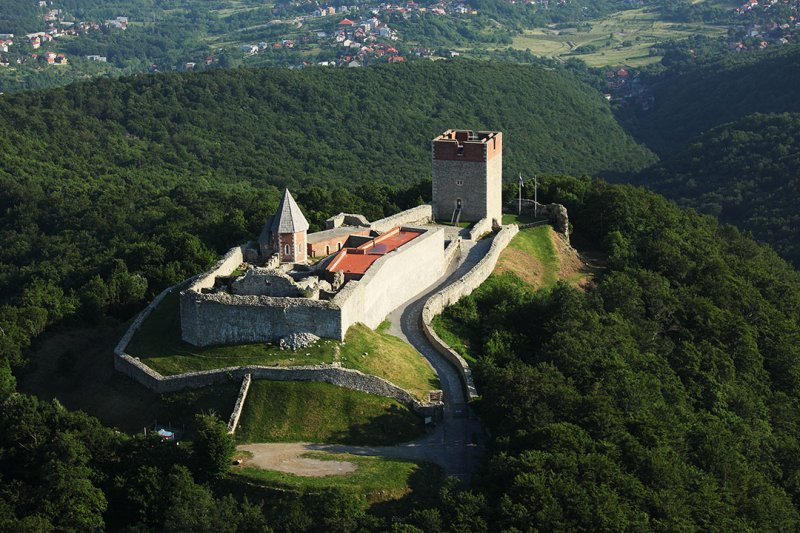
Image: Zagreb Tourist Board
St. Nicholas Fortress in Šibenik
The fortress of St. Nicholas, located at the entrance to the Channel of St. Ante in Šibenik, is a unique Venetian fortification. It was built on the island of Ljuljevac, on the site of the former Benedictine monastery of St. Nicholas, after whom it was named. The construction of the fortress, according to the project of the Venetian architect Gian Girolamo Sanmichelli, began in 1540 after the fall of the city of Skradin under Ottoman rule, when the Venetians had to strengthen the defense of Šibenik, its most important strategic port on the eastern Adriatic coast.

Image: Šibenik Tourist Board
Klis Fortress
Klis fortress was built on an extraordinary strategic location separating the mountains of Mosor and Kozjak that allowed military and commercial control over the whole Klis valley and the area of Salona and Split. Because of its importance, Klis was often referred to as the key to Dalmatia and the heart of the medieval Croatian kingdom. It was built as a small stronghold by the Illyrian tribe Dalmatae, then became a royal castle during feudal and medieval times, and lastly served as a major source of defense against the Ottoman advance.
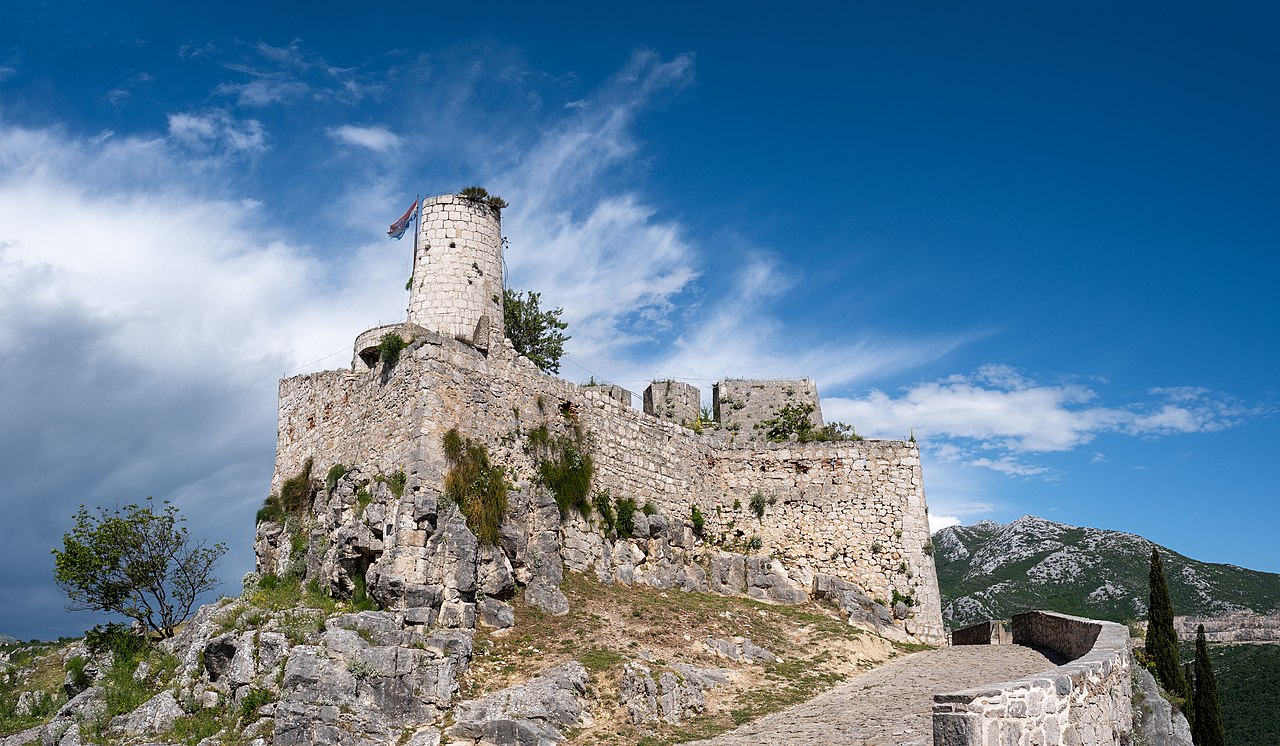
Image: Jules Verne Times Two/Wikimedia Commons
For more on travel in Croatia, follow TCN's dedicated page.
PHOTOS: Extraordinary Plants of Klis Fortress Show Two Sides of Dalmatia
January 2, 2021 – High on the mountains, overlooking the city of Split, the historic settlement of Klis stands on the border between two distinct climate regions – the Mediterranean and the Dalmatian hinterland. The sometimes rare and extraordinary plants of Klis Fortress are characteristic of both. A new book details the flora you can find on both sides of the Dinaric Alps
The views from Klis are spectacular. The great city of Split lies below you, perched on the edge of the glistening Adriatic, beyond it, the islands of Čiovo, Šolta, Brac, Vis and Hvar. It's a view that has been admired for over 2000 years. The view from Klis Fortress
The view from Klis Fortress
That's how long a fortress has stood here. Restructured and rebuilt several times over the millennia, within the walls of the impressive Klis Fortress lie much of the recent history of these lands – of the Illyrians and the Romans, the arrival of both Slavic people and of Christianity, the defence of Christian Europe from the Ottomans. So steeped in history are these walls, little wonder the fortress was chosen as a filming location for the popular Game Of Thrones series.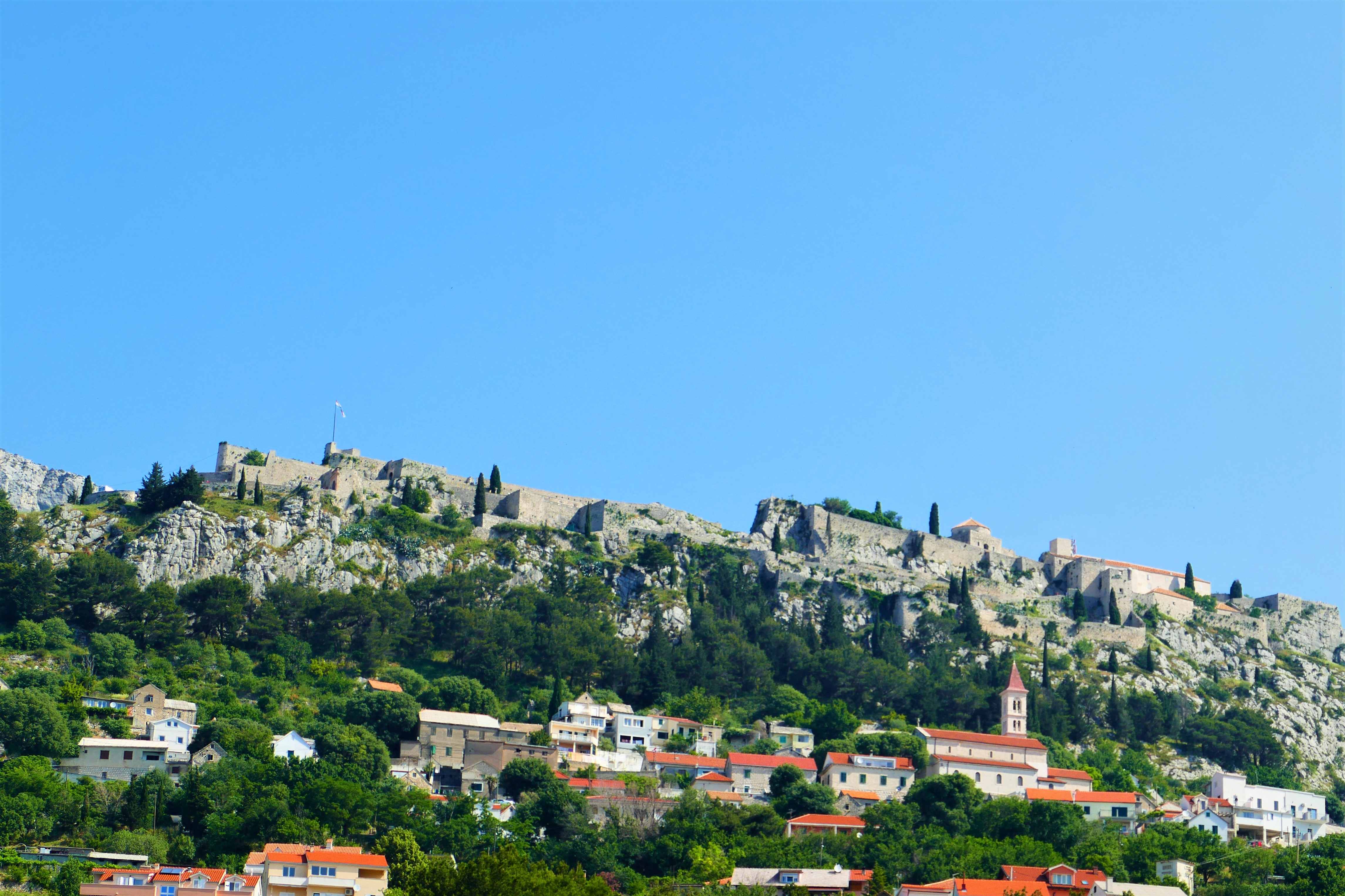 Klis Fortress
Klis Fortress
With its view so irresistibly inviting the eye, you could be forgiven for missing the plants of Klis Fortress. That's unfortunate. The fort straddles the top of the Dinaric Alps – one half existing within the sub-Mediterranean climate of the Dalmatian hinterland, the other on the distinctly warmer side of the Adriatic. This creates a unique environment for a wealth of flora. Not used as a fortress since the threat of Ottoman invasion subsided, these days the structure usually welcomes only tourists. The plants of Klis Fortress have reached into the grounds of the buildings, indeed into its very walls.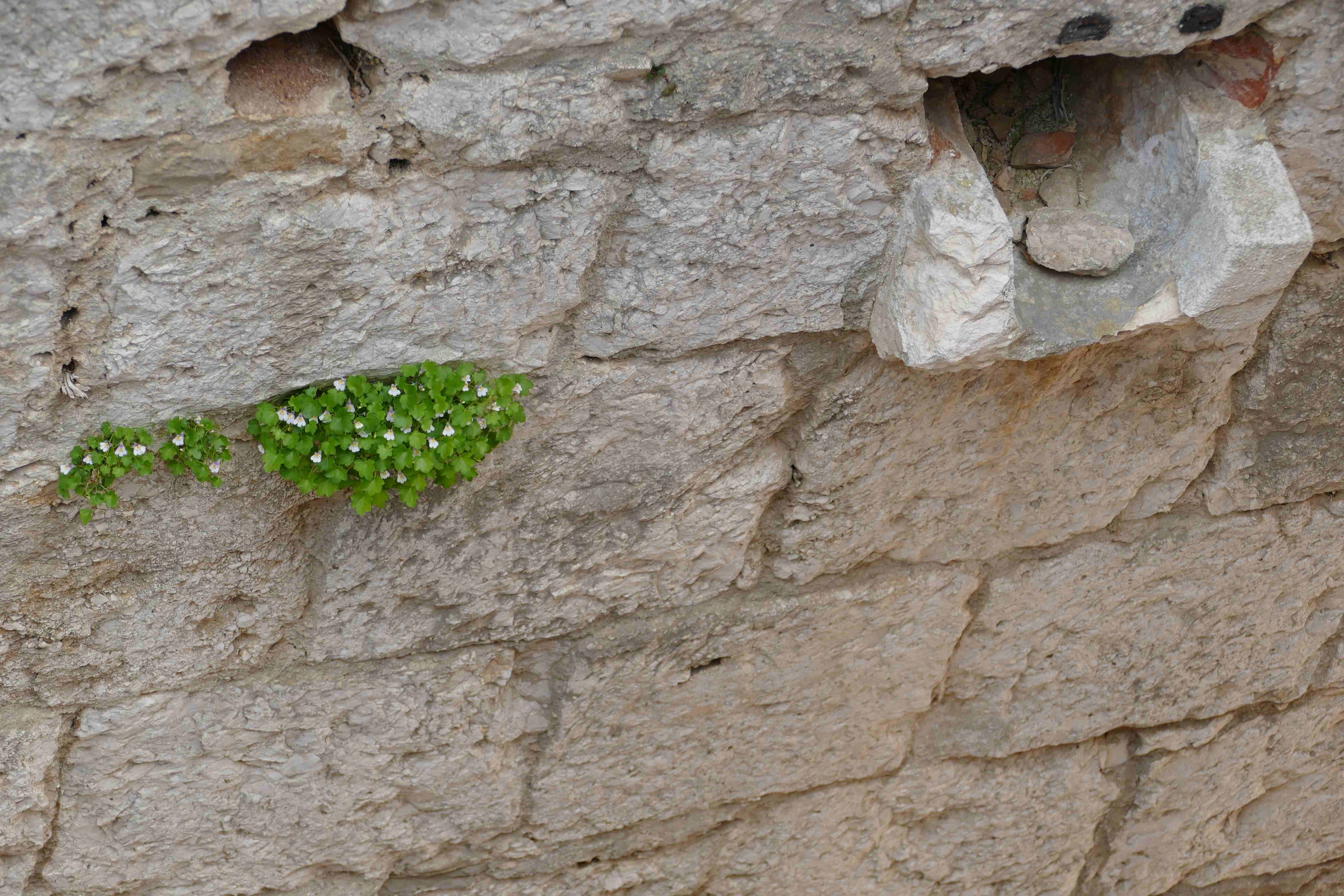 Cymbalaria muralis - Ivy Leaved Toadflax within the walls of Klis Fortress
Cymbalaria muralis - Ivy Leaved Toadflax within the walls of Klis Fortress
One person for who the plants of Klis Fortress did not go unnoticed is Ivan Limić. He lived in Klis all of his life, before leaving to get his degree, then a masters, at the Forestry department of the University of Zagreb. Today, he works for the Institute for Adriatic Crops and Karst Reclamation (IAC) on a PhD student's position. Having a specific interest in botany, he knows the plants of Klis Fortress better than most and after he met botanist Vedran Šegota of Herbarium Croaticum while in Zagreb, they decided they should work on a project together. After several years of work, that project - a book, 'Biljke Tvrdave Klis (Plants of Klis Fortress)' – has finally been released. Although helmed by co-authors Vedran and Ivan, it has actually been a project that involved a much greater group of contributors, not least the community of Klis and some of the best botanists in Croatia.
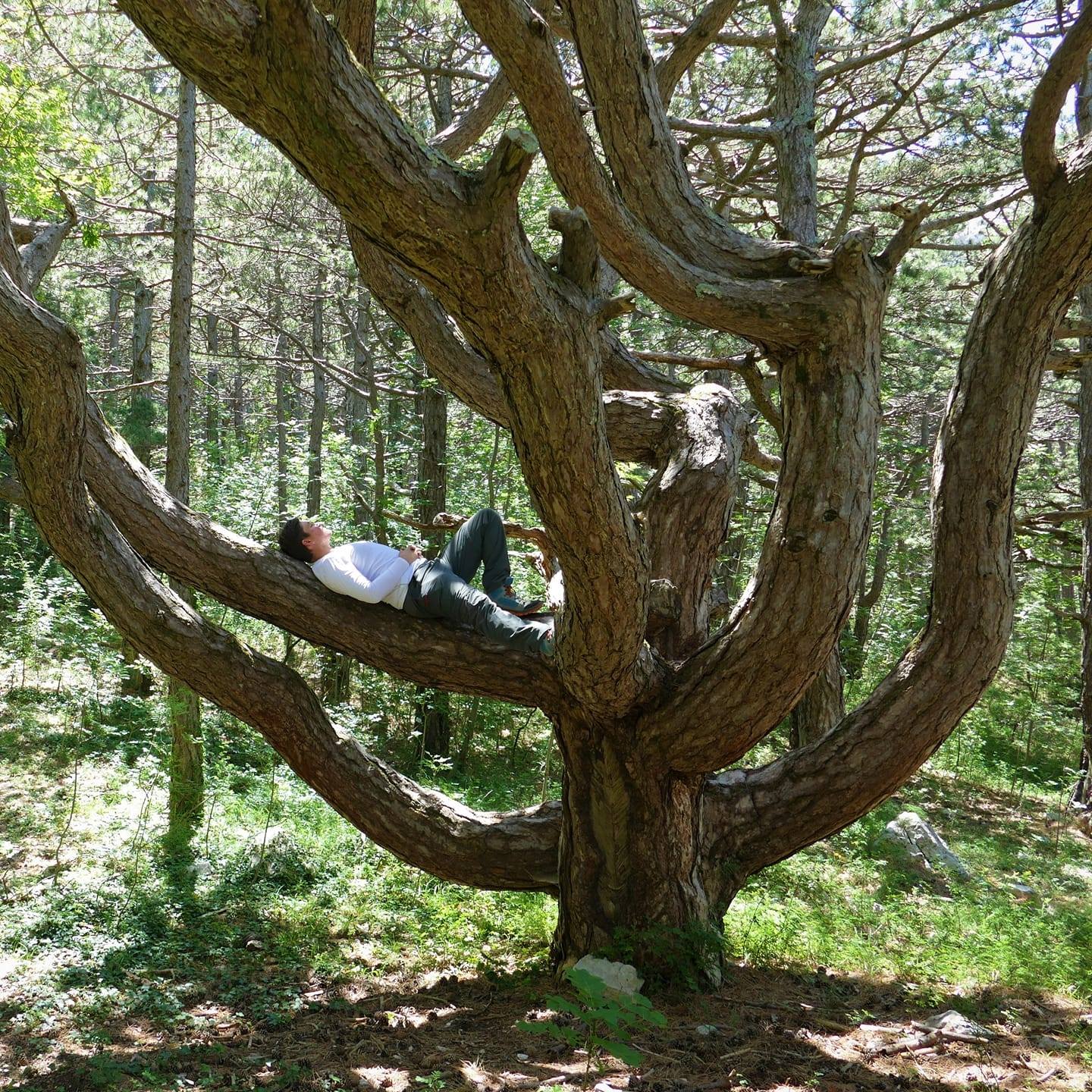
Ivan Limić, co-author of 'Plants of Klis Fortress', relaxing in a Black Pine
TCN talked with Ivan Limić to find out more about the book and about the plants of Klis Fortress
I first met Vedran when I started volunteering at Herbarium Croaticum Zagreb. I was in the city doing my degree. My main interests are forest silviculture and soil erosion, karst melioration, assessment of atmospheric deposition, study of flora, plant determination in Mediterranean region forest ecosystems and the effects of forest fires in those areas. We talked about doing a joint project because we shared similar interests. Vedran came to visit me in Klis and I wanted to show him around the fortress, but looking specifically at the flora. That's when we decided we should do a book about the plants of Klis Fortress.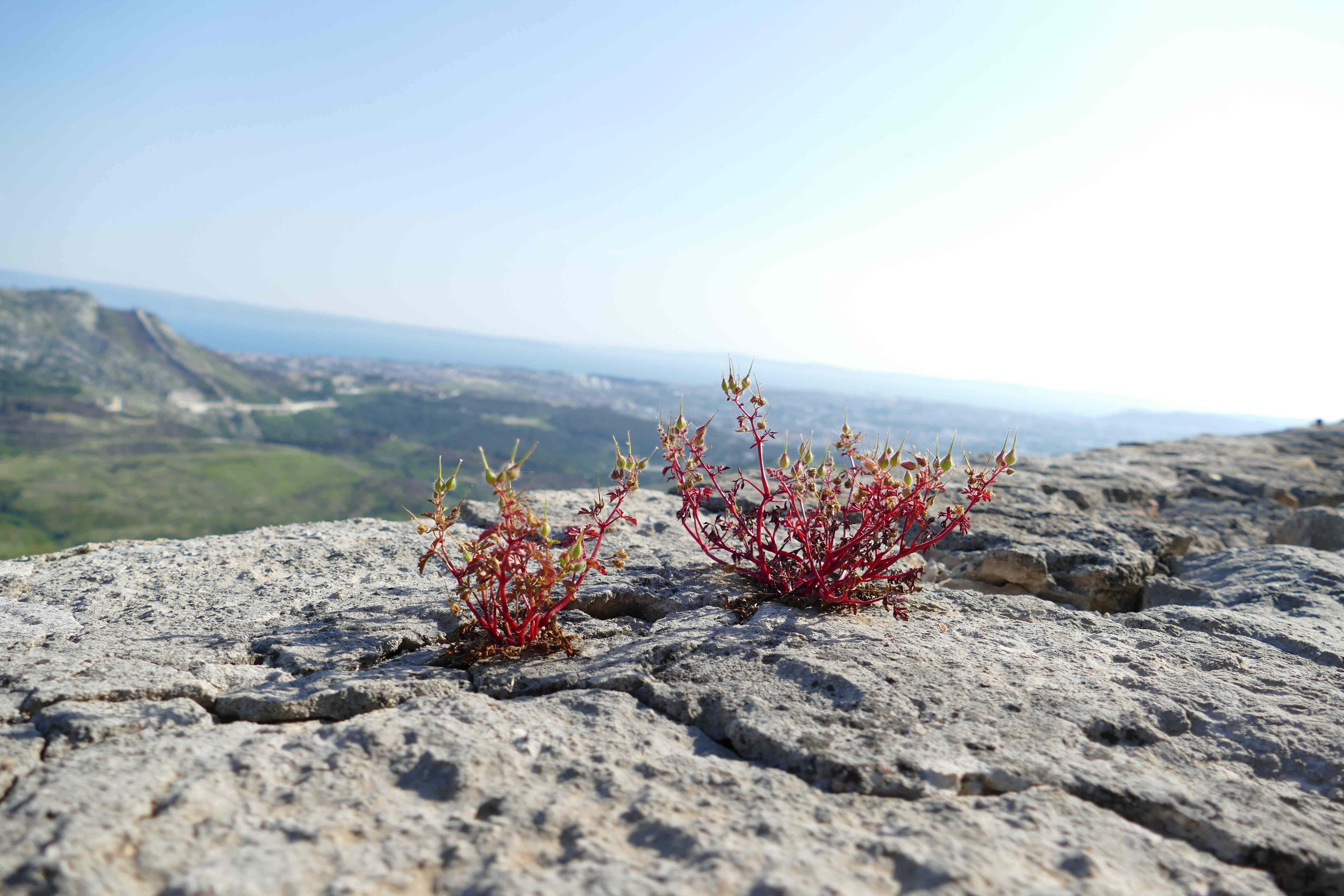 Geranium purpureum, the little-robin
Geranium purpureum, the little-robin
I walked around Klis Fortress all my life. When you live in a place, you not only acquire so much information about that place over the years, you also have an emotional connection to it. That's not something you can read in every book. Hopefully, with our book, we managed to get a sense of that emotional attachment across, so that you can really feel the place.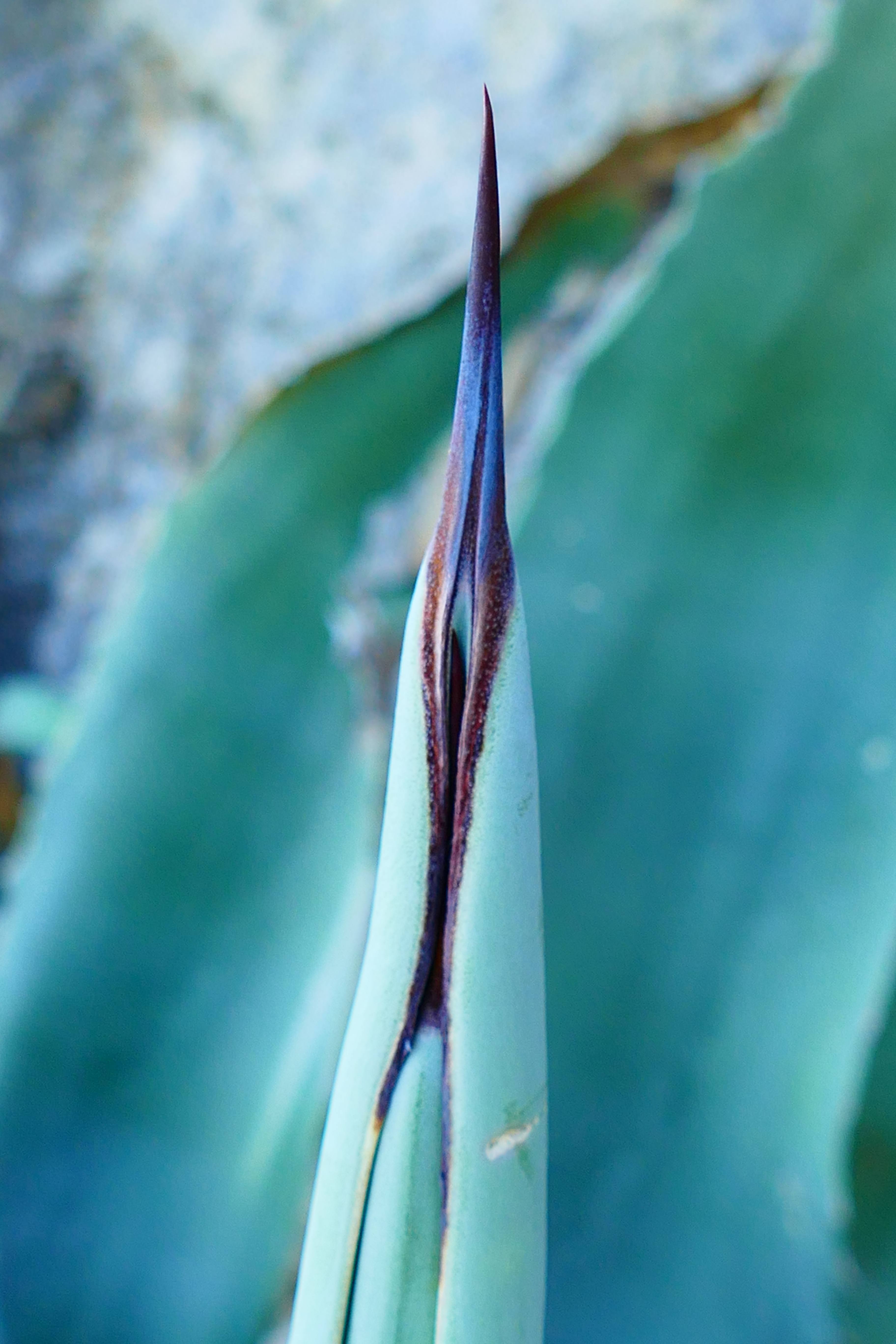 Agave americana
Agave americana
In a way, the special thing about the plants of Klis Fortress is that they are not so special at all – they are extremely characteristic. But, they are characteristic of two completely different climate regions.
On the south side of Klis Fortress, it is very warm and sunny – the Mediterranean climate. You can find species like Aleppo pine. On the northern side of Klis Fortress, it is colder – the sub-Mediterranean climate. Here, you can even get snow in winter and the most common species is Black pine. Two completely different climate regions in just a 50 metre stretch diagonally along the ground. That's what makes it extraordinary. Salvia officinalis (sage)
Salvia officinalis (sage)
The plants of Klis Fortress include more than 300 species. We have around 100 of them listed in the book. Of those, 16 are species endemic to this area. Some of those are extremely rare - you can find them in very few places in Croatia - such as Fibigia triquetra. That plant is actually one of the reasons why this book exists. When I was a child, people used to tell me that some of the plants of Klis Fortress were very unusual and very rare. I used to walk around the fortress, looking at all the plants, trying to guess which ones were the unusual and rare species.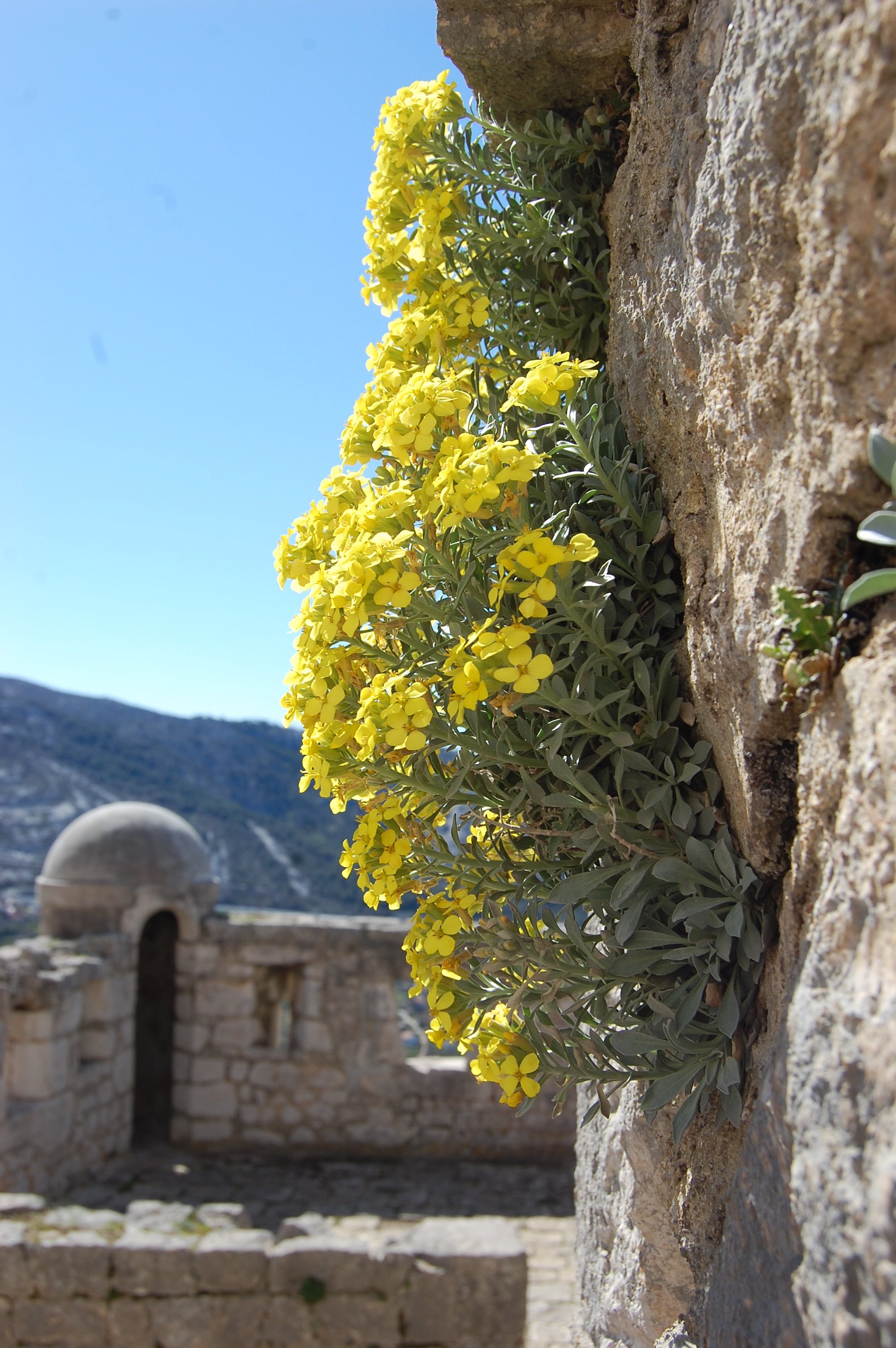 Fibigia triquetra
Fibigia triquetra
The man who first identified this as a unique, endemic species actually discovered his first specimen inside Klis Fortress. All of the studies and writings he made about the plant were done here. That plant is now the symbol of Klis Fortress. Polypodium cambricum
Polypodium cambricum
You can find our book in Klis library. Anyone can borrow it. It's also available at the entrance to Klis Fortress, where you buy the tickets. We wanted to give the opportunity to anyone who comes here to learn about the plants of this region – that's why we made such an effort to have the book in five languages. It was designed as a guide to the plant species of the whole Mediterranean mountain region in Croatia, so it's not just for the plants of Klis Fortress or the people who come to Klis Fortress itself.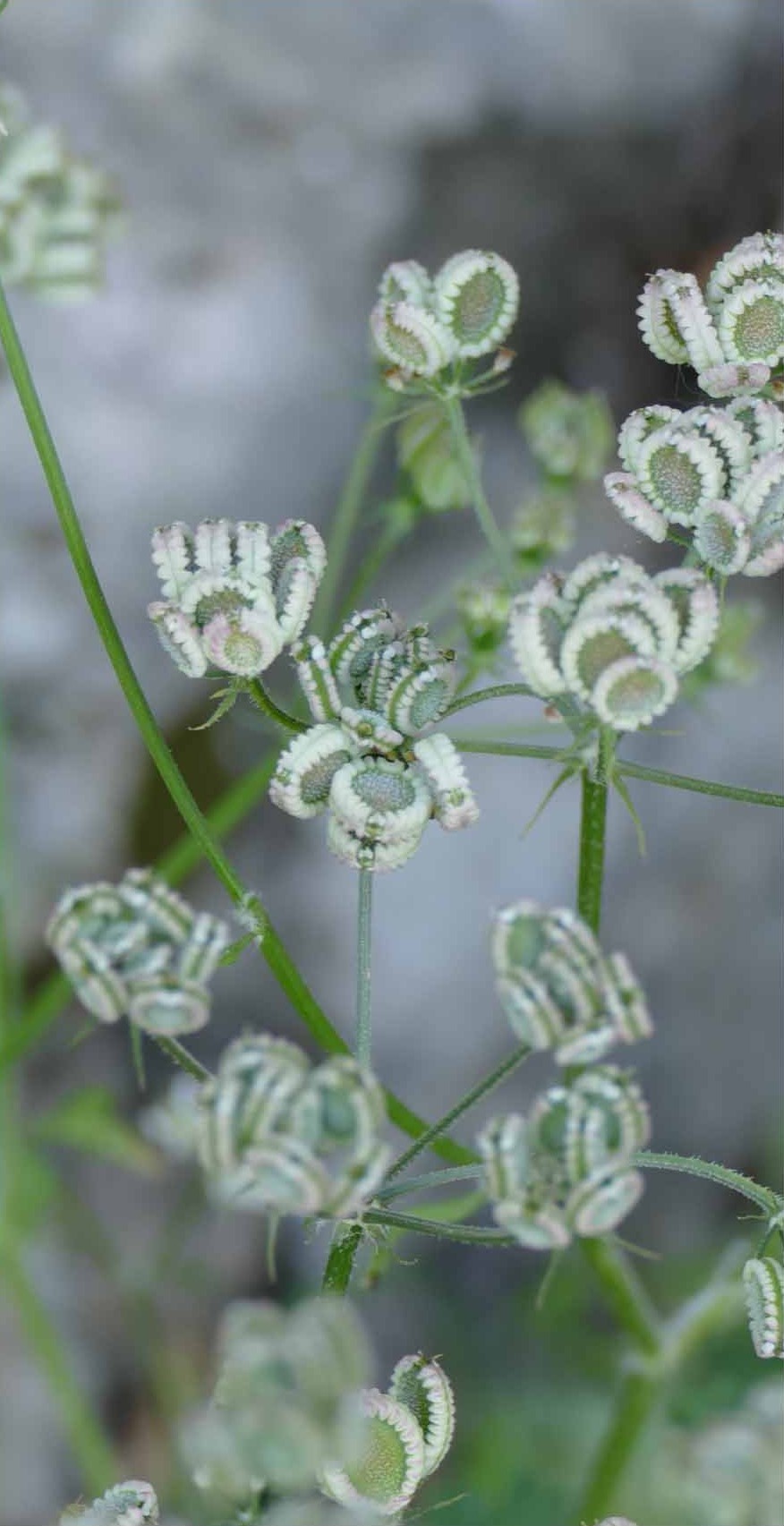 Tordylium
Tordylium
Most of the photography in the book was done by ourselves. It was important to take the photographs across four different seasons. That's one of the reasons it took almost two years to write this book.
 Inula Verbascifolia
Inula Verbascifolia
As we were making progress on the book, people in Klis began to find out what we were doing. It ended up becoming a project of the wider community. The mayor of Klis supported the project financially so that we were able to publish the book professionally and the library of Klis edited and published the book.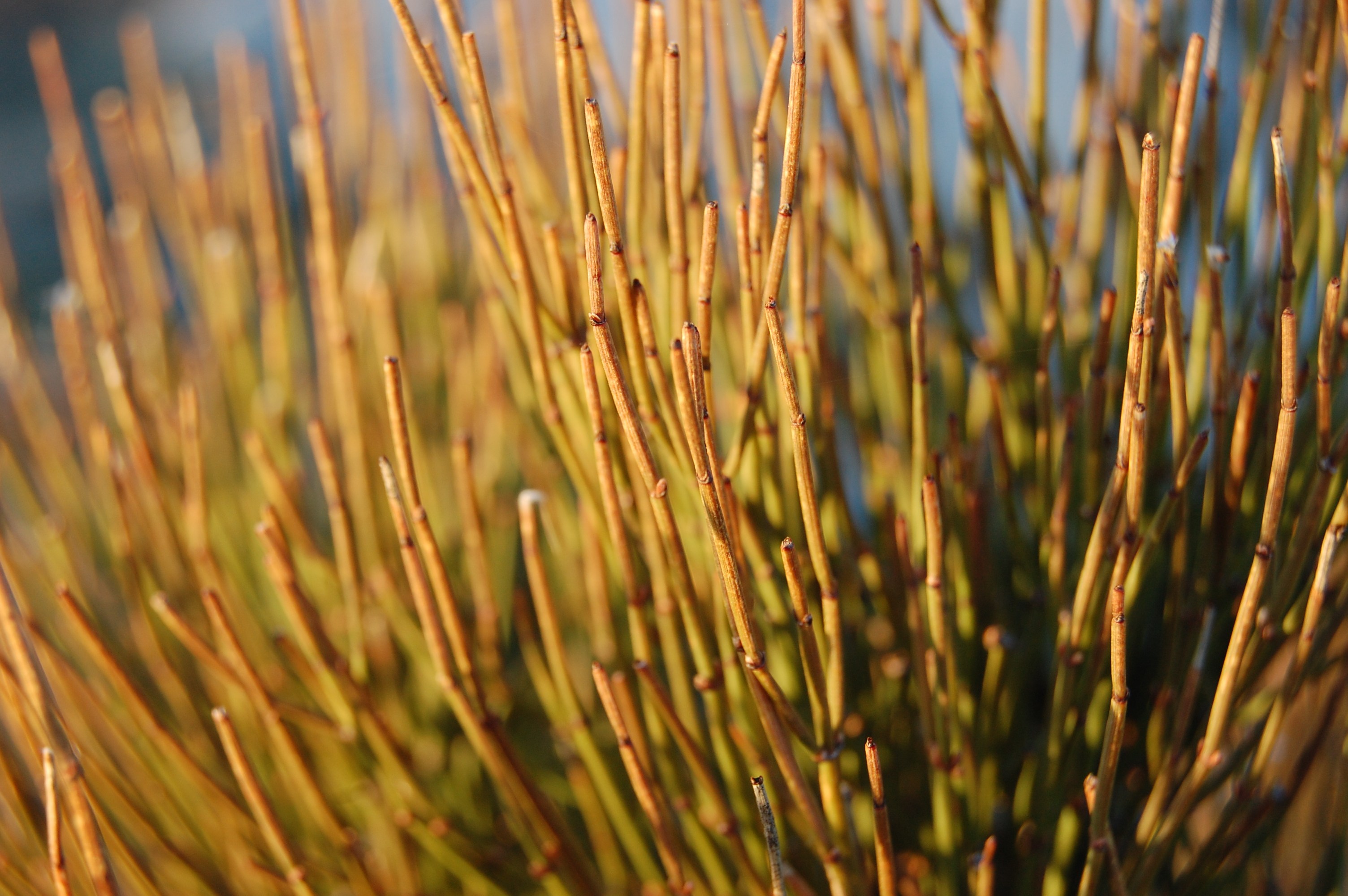 Ephedra major
Ephedra major
Others contributed to the design of the book and the translations, of course. Almost all of them donated their time and work to the project for free. It is quite difficult to translate some of this specific text correctly and we wanted to get it absolutely right. 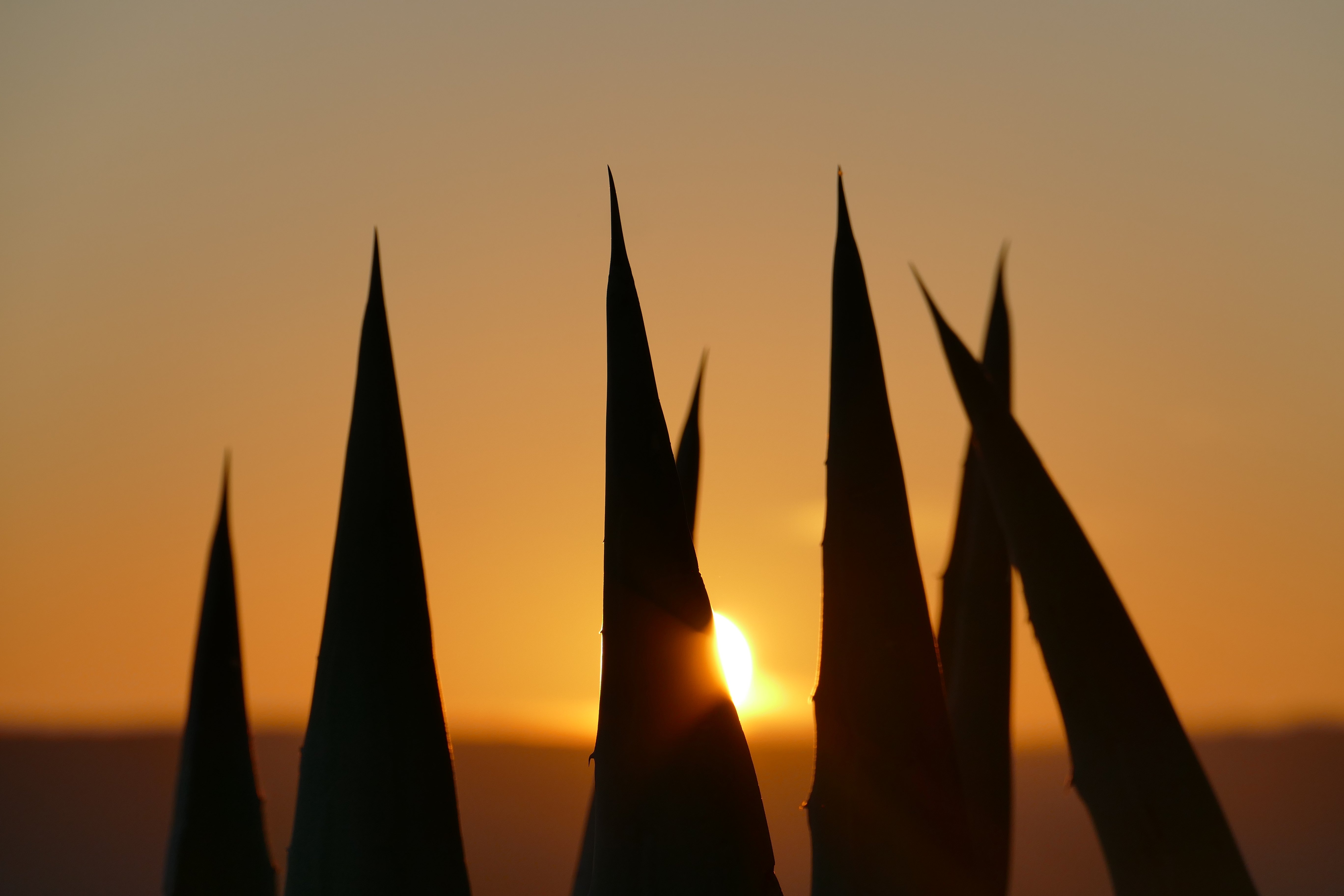 Agave americana
Agave americana
In the end, we ended up getting contributions from Italy and France, we had one colleague from the French embassy who helped and some of the best botanists we have in Croatia contributed to the book to make sure everything was absolutely correct. For that reason, the book was approved and recommended by the Botanical Society of Croatia and can be found in the Botanical library.
All images © Ivan Limić / The Plants of Klis Fortress
New Klis Fortress Tourist Attraction: Construction of Summer Stage Soon Begins
December 1, 2020 - A new Klis Fortress tourist attraction should hopefully welcome visitors next year - a brand new summer stage.
Dalmatinski Portal reports that the Municipality of Klis announced that the public procurement procedure for the selection of contractors to build a new summer stage at the Klis Fortress is nearing completion, which will further improve the content and offer of cultural events at one of the most important and beautiful fortifications in Europe.
Thanks to the successful withdrawal of European funds, the Municipality of Klis, through the ITU mechanism of the Urban Agglomeration, has provided funds to build and equip a new summer stage at the Klis Fortress. The signing of the contract with the selected contractor is expected in December, and in addition to the summer stage, the reconstruction of the artillery barracks, the rehabilitation of the small quarter, and the protection of the fortress from vegetation are also planned. The project is worth 5.5 million kuna, and 85 percent of its value is funded by the European Union.
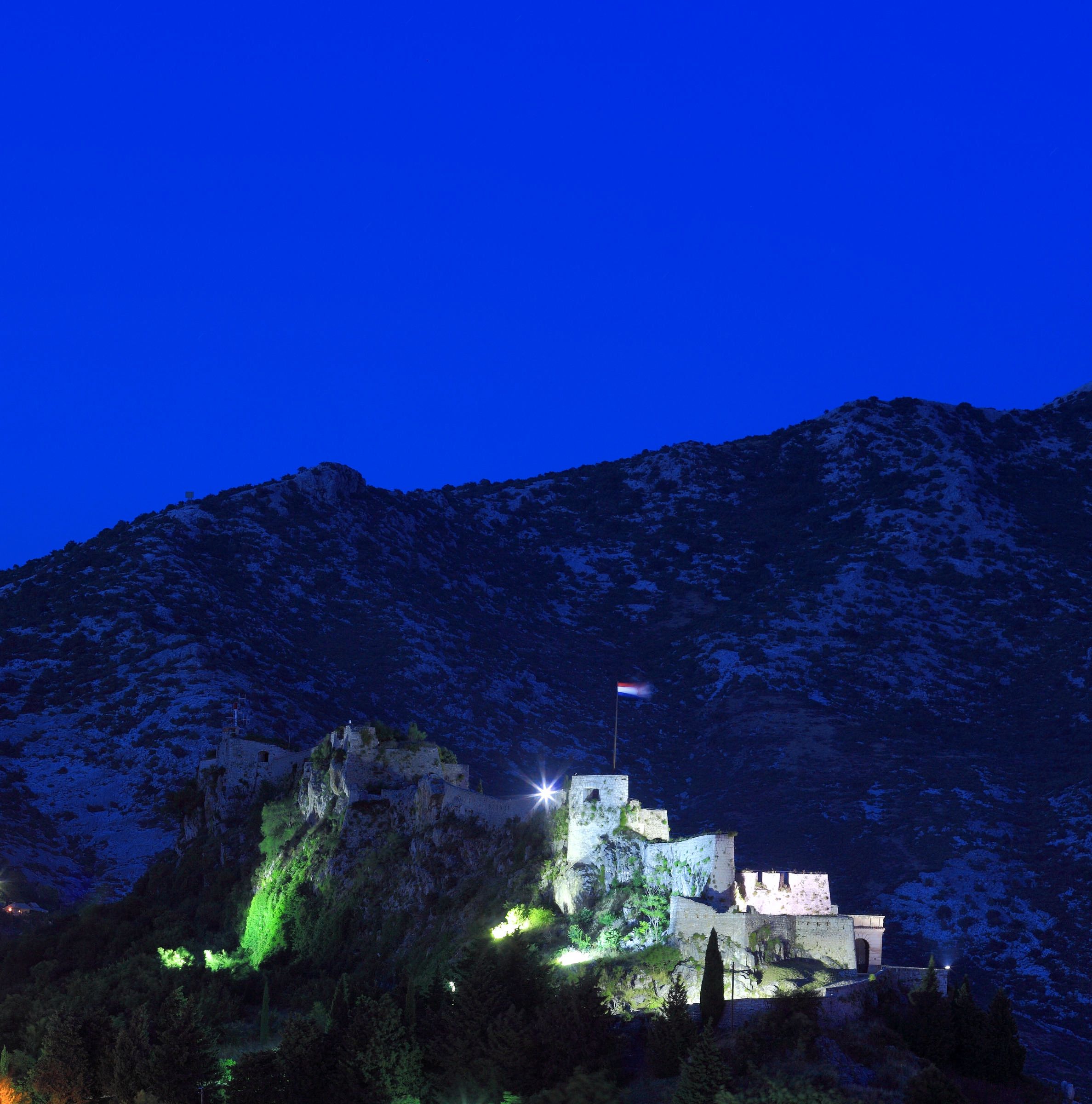
Romulic & Stojcic
"We hope that in the summer, if epidemiological conditions allow, we will be able to watch and listen to the performers of numerous cultural and entertainment events on the new stage, which bring together both domestic and foreign tourists, as well as the locals of Klis. Last year, as many as 100,000 visitors who enjoyed the beauties of this world-famous medieval fortress were exceeded and we are proud to valorize its tourist potential through the sustainable and responsible use of cultural heritage," said Jakov Vetma, Mayor of Klis.
Klis Fortress is one of the most important cultural and historical monuments in Croatia, which in recent years has gained recognition in the world thanks to its role in the HBO's series 'Game of Thrones', which was partly filmed in Klis.
The Municipality of Klis continuously invests significant funds in revitalizing the Fortress and enriching the facilities it offers, thus contributing to the tourist image and offer, not only of the Klis region, but also of the entire region.
To read more about lifestyle in Croatia, follow TCN's dedicated page.
Klis Fortress Above Split Enjoys Record Number of Visitors
If you've ever made the drive down to Split, you'll have noticed a curious old fortress located in the rugged hills overlooking the city. This incredible medieval fortress, or what remains of it, is named after the village in which it is located - Klis. Klis Fortress has been conquered many times during Croatia and the wider region's tumultuous history. Originally constructed by the Illyrians, it took on its final shape during the Ottoman wars, when the marauding Turks had their eye on the area.
Klis Fortress is a very popular tourist destination, with history buffs, those who love the bird's eye view over Split, photographers and everyone in between wanting to see this imposing piece of history standing tall above the popular Dalmatian city.
Owing to its continued development, as well as investments having been made, Klis Fortress has experienced a record number of visits from tourists in 2019.
As Poslovni Dnevnik/Marta Duic writes on the 23rd of December, 2019, Klis Fortress and the increase of tourists visiting it, fuelled by the fact that it is one of the top locations of the filming of the wildly popular Game of Thrones series is a peculiar phenomenon of Dalmatia.
Although the ancient fortress is a flywheel when it comes to development, with investments and a wise strategy, it managed to obtain visitor numbers that it has every right to boast about.
The number of visitors to Klis Fortress back in 2015 was a mere 12,000, the following year it increased significantly to 32,000, and in 2017, those numbers reached an impressive 47,000.
After last year's 70,000 visitors, the upward trend has continued and more than 100,000 people visited Klis Fortress this year. The year was also marked by the opening of the Interpretation Centre worth 1 million kuna in total, in which visitors are introduced to the historical and cultural heritage of the region through an informative 3D hologram projection.
Thanks to the EU project worth 2.8 million kuna, special lighting has been erected on Klis Fortress, and the reconstruction of two buildings within the fortress and the installation of a summer stage with a pricet tag of 5.5 million kuna are now being prepared.
Make sure to follow our dedicated travel page for much more.
Klis Fortress Logs This Year's 100,000th Visitor
ZAGREB, November 3, 2019 - The Klis Fortress logged this year's 100,000th visitor on October 29, 51% more visitors than at the same time in 2018, and this year's ticket revenue is a record-high 5 million kuna, according to the information provided by the authorities of Klis Municipality overlooking the City of Split.
Municipal head Jakov Vetma said the municipality was "investing a lot in the reconstruction of the fortress and in expanding products. Thereby we contribute not only to tourism and development of our community but the whole region."
Klis Fortress is one of Europe's most important and most beautiful fortresses and its cultural heritage deserves to be properly promoted for tourism, he said.
Part of the money made from tickets will be invested in key infrastructure projects and population measures intended to improve the quality of life, Vetma said.
The fortress stands on the steep cliffs of the gorge between Kozjak and Mosor mountains.
"It was built on an extraordinary strategic location that allows military and commercial control over the whole Klis valley and the area of Salona and Split. Because of its importance, Klis was often referred to as the key to Dalmatia and the heart of the medieval Croatian kingdom," according to the information available on the Kliss Fortress website.
"Klis’s greatest significance for Croatian history dates back to the 15th century when it found itself at the crossroads of the three empires – the Ottoman Empire, the Venetian Republic and the Habsburg Monarchy. Klis was the home of the Uskoks, military units that got their name because they jumped into („uskočiti“ in Croatian) the enemy territory, pillaged it and returned to their base. The leader of the Klis Uskoks was Petar Kružić, who defended the fortress with his men for more than twenty years against powerful Ottoman army. Nevertheless, with very poor help from the Habsburg ruler Klis could not resist forever, and in 1537 it fell into Turkish hands."
The fortress had its last major role in the military sense during the War of Candia between the Venetian Republic and the Ottoman Empire. In the end fell into the hands of the Venetian army in which many Croatians were conscripted. "From that point on, Klis will no longer see larger military action beneath its walls – it remains in Venetian hands until 1797 when it comes under the French rule. By the fall of the First French Empire fortress became part of the Habsburg Monarchy, and with its abolishment it shared the fate of Croatian territories until 1990, when the flag of Republic of Croatia was flown over it," according to the history of this landmark of the Split hinterland.
More Klis news can be found in the Lifestyle section.
Modern Interpretation of History Presented on Klis Fortress
At the foot of the hill where Klis Fortress is located, the long-awaited Interpretation Centre was recently opened. Klis Fortress is one of the most significant symbols of the rich history of that part of Croatia, and the history and the cultural heritage of the area will be presented to visitors through 3D holographic projections, in a unique combination of modern technologies and history, hrturizam.hr writes.
The project includes the illumination of the exteriors of the buildings at the centre of the village with images of well-known locations, as well as the possibility of 3D mapping on the outside walls of the Interpretation Centre which creates attractive visual content without additional interventions in the space.
The idea of the Centre started four years ago when the Klis Municipality applied for the funds for tourist development with the Ministry of Tourism. The value of the adaptation and the turning of the already existing building into the Centre was around one million kuna, and the Ministry and Split-Dalmatia County invested more than the half of the amount.
At the opening of the Centre, Jakov Vetma of the Klis Municipality said that the project allowed them to offer their visitors the added value.
They will be able to learn about the specificities of the region and the history of the region told in a modern way. Klis was the first capital town in Croatia, and has been a seat of Croatian kings for ages. Nowadays, it's going through a tourist boom, having received over 70,000 visitors last year, mostly thanks to the restauration project of the fortress itself, which then became world-famous after some of the worldwide phenomenon Game of Thrones series was filmed there, and the numbers kept increasing: in the first five months of this year, Klis Fortress has seen an increase in the number of visitors by around 60 percent compared to the record-breaking 2018.
The people of Klis are not stopping their development plans here; they're preparing the project of building a summer stage on the fortress, which is worth over five million kuna. The other major project for Klis in the near future is the sale of a very valuable piece of property where an attractive hotel should be built, which should bring more investors and tourists to Klis.
From Dalmatae to Daenerys, Klis is Dalmatia's Medieval Hotspot
April 10, 2019 - Unless you belong to the 1% of people who have never seen an episode of Game of Thrones (enter meme here), we’re pretty sure you’re aware that the final 8th season of the wildly popular TV series begins on April 14th. While you’re busy recapping the last seven seasons and brushing on the characters and powerful families in the medieval fantasy epic, we thought we’d offer you help by looking at one of the many Game of Thrones filming locations in Croatia - Klis fortress.
Long before it was known as the city of Meereen in the popular HBO series, the 2,000-year-old medieval Klis fortress was one of Croatia’s historic symbols, with a stellar view overlooking Split to boot.
Located less than 30-minutes away from the Dalmatian capital in the town of the same name, Klis fortress is essential to the history of Split and boasts a world of history itself. A strategically important structure thanks to its location between the Kozjak and Mosor mountains, the fortress controlled access to and from Bosnia, Dalmatia, and Inland Croatia.
The fortress was first inhabited by the ancient Illyrian tribe of Dalmatae, followed by the Romans, the Byzantines, the Croats and the Ottoman Turks who famously conquered it in 1537. Onto the Venetians, the Austrians, and the Axis powers during WWII, the Klis fortress has seen it all - and you could see it all too.
The popular attraction is not much further than the town of Solin and the archaeological site of Salona and is also easily reachable by bus lines 22, 34, 35, and 36 from Split.
And thanks to its accessibility, the Klis fortress registers an increase in domestic and foreign visitors from year to year. Namely, last year, more than 70,000 people visited the famous fort, which is 40% more than in 2017. A positive growth trend continues in 2019, and during the first three months of this year, the number of visitors increased by 46%, and revenues by 66% over the same period last year. Consequently, the revenues of Klis fortress increased by over 3 million kuna, which is an unprecedented amount so far.
But that’s not all for the favorite fortress. Thanks to EU funds, Klis fortress will be illuminated at night this tourist season. Croatia’s first capital is part of the project financed by the European Union - the IPA Interreg ‘Fortress ReInvented’ project submitted by Croatia, Bosnia and Herzegovina and Montenegro. The project focuses on the reconstruction of the historical fortresses in the area and the Klis fortress portion of the project is worth 2.4 million kuna (350,000 euro). Most of all those funds will go towards illuminating the fortress at night.
The mayor of Klis, Jakov Vetma, explained that illuminating the fortress at night is no new idea. In fact, all the documentation for the project was done several years ago. Vetma is confident that the fortress will attract even more visitors once it's illuminated. The deadline for the works to be completed is 90 days, meaning it should be finished right in time for the high tourist season.
TCN wrote back in February that Klis fortress is also considered an archaeological paradise, with renewed interest by experts since a new, yet unknown site was found near the St. Vid Church. The wealth of the archaeological findings in the area is the only real danger to setting up the new lights at the fortress, as the process itself might be slowed down if something yet unknown is discovered while construction is underway. Also in the plans for this famous fortress is a summer stage. Specifically, the Klis municipality plans to reconstruct the artillery barracks and acquire a mobile stage with 3D mapping, which should be ready for next year.
While the fortress is Klis’ main attraction, the municipality is on its way up, too. Not only is Klis is part of Inland Dalmatia, which was declared the best destination of rural tourism last year, but mayor Jakov Vetma believes that few places in Croatia have such a rich history like Klis, and even claimed that it shouldn't be named a municipality, but a town. The Municipal Council and the Council of Split-Dalmatia County agree, and have even supported that petition. Although the current number of inhabitants wouldn't support the decision, Vetma believes that it’s the people in the past and the present that make a town, not buildings.
“The city is made up of people, not buildings. And the important people throughout the history of our people who ruled, lived, and battled in Klis give us that right,” said Vetma.
It would also be easier to get European funding for future projects if Klis was considered a town, which would improve visibility, development and a better standard for the inhabitants.
Nonetheless, Klis is continuously raising the standard of living of its local community, arranging kindergartens and schools, sports facilities, transport, and tourism infrastructure, purchasing textbooks, increasing the number of newborns and encouraging and developing new economic and entrepreneurial initiatives. And in the development of cultural tourism, Klis will continue being branded as a historical town with a series of sites around the Klis fortress.
Apart from its spotlight in Game of Thrones, Klis is a Dalmatian destination you shouldn’t pass up on your next trip to the region, and its future is only getting brighter.
While you’re already visiting Klis, make sure to check out some of Dalmatia's other Game of Thrones filming locations, which you can find listed below:
Ulica Sv. Dominika in Dubrovnik: Inside the untouched walls of the Old Town, this winding alley in Dubrovnik was ideal for the murder of King Robert's illegitimate sons and the ‘walk of shame’ by Cersei Lannister.
Ethnographic Museum: The impressive Dubrovnik building from the 16th century acts as a brothel where Tyrion Lannister meets Oberyn Martell in the fourth season.
Pile: The western entrance to Dubrovnik and one of the most beautiful locations overlooking the fortresses of Bokar and Lovrijenac is Blackwater Bay in the GoT series. In the third season, Shae and Sansa Stark watched ships sail here before Littlefinger made plans to escape with Sansa.
Bokar Fortress: This Dubrovnik fortress appears in the second and third season of the series, and is particularly apparent when Varys and Tyrion talk about their battle strategy for defeating Stannis Baratheon's army as they look to the sea. In reality, the medieval fortress on the city walls of Dubrovnik is open to the public all year long.
Lokrum island: Six hundred meters from the mainland, GoT fans will find the city of Qarth. It is, in fact, the island of Lokrum, where Daenerys Targaryen awaits the Spice King, knowing that he is in danger. In reality, Lokrum is no less mysterious and fascinating. Legend states that King Richard the Lionheart sought shelter here in 1192 after returning from the Crusades.
Arboretum Trsteno: The oldest arboretum in this part of Europe was built in the 15th century, has a spectacular view of the Adriatic and is only 20 minutes away from Dubrovnik. You might recall scenes from the gardens of King's Landing, and memorable scenes with Lady Olenna.
Diocletian’s Palace: Many scenes with Daenerys were filmed in Split, inside Diocletian's Palace. It is where she sits on her throne, trains her dragons, and where her slaves contemplated whether they should fight for the 'Queen of Dragons'.
Trogir: The best-preserved Romanesque-Gothic city of Central Europe with an impressive cathedral and Kamerlengo fortress was conceived as the trade port of Qarth. There, the rulers of Qarth captured Daenerys' dragons.
Kaštel Gomilica: The medieval castle and its surroundings were transformed into Braavos, a town on the sea that Arya Stark was sent to at the end of the fourth season. You might recall Arya taking the name 'Cat' and living with Brusco and his daughters.
To read more about travel in Croatia, follow TCN’s dedicated page.
Klis Fortress near Split to be Illuminated at Night
Starting later this year, during the upcoming tourist season, the Klis fortress (best known around the world as the place where Khaleesi kept her dragons in the HBO's mega-hit show Game of Thrones) will be illuminated during the night!
The fortress of Klis has been an amazing place to visit not only for the Game of Thrones fans in the past several years but also for all those in love with the medieval archaeology, fortresses, historical armed forces and the tourists who expect to get more out of the vacation experience. Recently, a contract was signed in Klis which guarantees that the fortress will become even more interesting in the future when it becomes illuminated during the night. The former Croatian capital is a part of the project financed by the European Union, IPA Interreg ‘Fortress ReInvented’ project submitted by Croatia, Bosnia and Herzegovina and Montenegro. The whole project is about the reconstruction of the historical fortresses in the area, and it was submitted by Šibenik Museum for their St. Michael's fortress reconstruction. The Klis fortress portion of the project is worth 2.4 million kuna (350 thousand euros), and almost of all those fund will go towards the illumination of the fortress during the night.
Slavica Vuković writes for Večernji list about the plans, and the municipal prefect of Klis Jakov Vetma explains that the plans for the night-time illumination have been around for a while. All the documentation for the project has been done several years ago, he says, and now the project will be finalized. The illumination will make the fortress even more attractive, and more visitors will come. In 2018, there were 70.000 visitors at the fortress (an increase of over 50% compared to 2017, which also held a record!), and the prefect is sure that the fortress will be able to attract even more people, once it's illuminated. The deadline for the works to be completed is 90 days, so even in Croatia, that means that everything should be finished right in time for the high tourist season.
Klis fortress is considered to be an archaeological paradise as well, with renewed interest by the experts since a new, yet unknown site was found near St. Vid Church. The wealth of the archaeological findings at the area is the only real danger to the setup of the illumination on the fortress, as the process itself might be slowed down if something yet unknown is discovered while digging for the lighting.
Klis Fortress Unites Uskoks and HBO's Game of Thrones
The view from the Klis fortress towards Split and the central Dalmatian islands is something special indeed.


